Survival Suit Sailing: Ensuring Safety at Sea
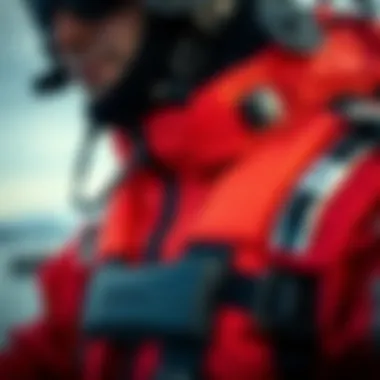
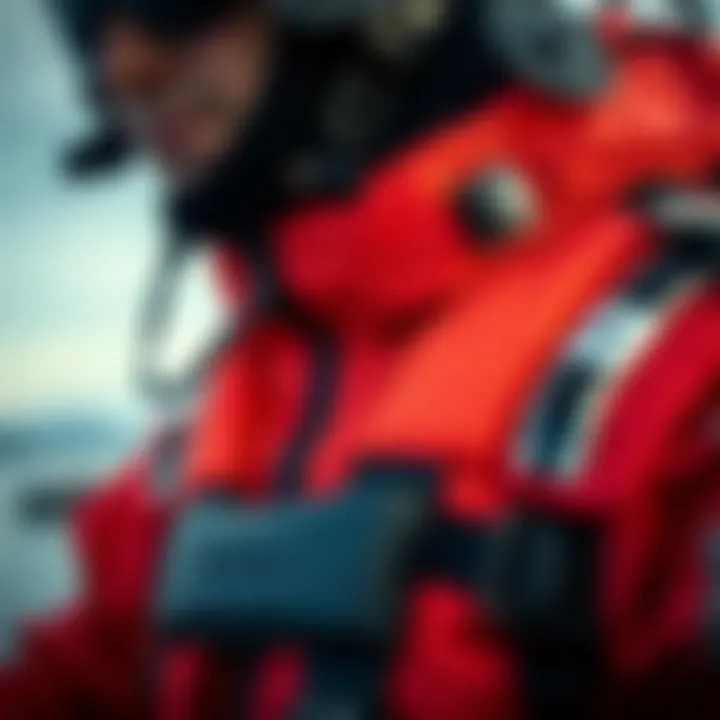
Intro
Sailing amidst the vastness of the open water can be both exhilarating and daunting. With the gentle sway of waves beneath your vessel, it’s easy to forget the potential hazards lurking beneath the surface. One such lifeline in the unpredictability of maritime adventures is the survival suit. As weather patterns can shift in an instant, having the right gear isn't just smart—it's a necessity.
Survival suits provide essential protection against hypothermia and other risks that could arise during sailing mishaps. This article encapsulates the critical aspects of survival suits, from the nuances of various types to features that could mean the difference between life and death. We will also touch upon how to properly fit these suits, care for them, and navigate the plethora of legal standards that come into play. Whether you're a seasoned sailor or new to the waters, understanding the role of survival suits can transform your approach to maritime safety.
Equipped with the right knowledge, sailors can take informed steps towards ensuring not just their own safety but that of their crew as well. Let’s delve into the various facets of survival suits, unraveling their importance one stitch at a time.
Prologue to Survival Suit Sailing
When one sets sail, the sea can often be as unpredictable as a tossed coin. The importance of survival suits in this environment cannot be underestimated. They serve as an essential layer of protection, not just against the frigid water but also against harsh weather conditions that can change in a heartbeat. More than just a piece of gear, a well-designed survival suit can be the difference between life and death in emergencies at sea.
Without a doubt, understanding survival suits goes hand in hand with the principles of safety. These specialized garments are designed to provide buoyancy, insulation, and in some cases, even visibility. Taking a moment to appreciate their functionality and the technology behind it could profoundly affect the decision-making of anyone involved in sailing or kiteboarding. The stakes are high; thus, knowing what to look for in a survival suit may save lives.
Whether a novice sailor or an experienced sailor, being in the know about survival suits equips individuals with crucial insights to navigate potential maritime crises. The key features of thermal insulation, fit, and durability factor predominantly into the effectiveness of these suits, presenting considerations that cannot be overlooked. The understanding established in this introduction lays a groundwork for a deeper exploration of survival suits, ensuring that every sailor is amply prepared for any challenges the ocean may present.
Understanding the Concept of Survival Suits
Survival suits are specially crafted garments that are designed to keep individuals afloat and warm in cold water. But they don’t just create waterproof barriers; they enhance survival chances in precarious situations. These suits usually come in two varieties: fully insulated immersion suits and lighter suits such as Gumby suits or drysuits, each serving unique purposes based on the situation.
The construction of these suits is tailored, embodying features such as watertight seals, reflective strips, and sometimes integrated buoyancy aids. This is where safety and performance merge seamlessly. Imagine navigating turbulent seas with the knowledge that your suit will keep you insulated while ensuring that rescuers can spot you even from afar. Not to gloss over the significant reality that many sailors don’t grasp the gravity of suit selection, which carries implications for personal safety.
Historical Evolution of Survival Suits
The evolution of survival suits is a story of innovation fueled by necessity. Initially, sailors relied on basic gear that provided minimal protection, like oilskins and woolen layers. As maritime safety concerns rose, the 1960s brought a paradigm shift with the introduction of more advanced materials and designs. Gradually, survival suits transformed from simple coverings to sophisticated lifesaving devices that could withstand extreme conditions.
Through the decades, the approach to survival gear has also been influenced by notable maritime disasters, where the lack of effective suits highlighted glaring gaps in safety protocols.
In contemporary times, survival suits have benefitted from ongoing research and technological advancements. Increased accessibility to new materials, coupled with a more profound understanding of thermal dynamics, has led to suits that are not only effective but also comfortable to wear. Continuing education and awareness of these historical lessons enrich the current sailing narrative, cementing the importance of survival suits in maritime security.
Types of Survival Suits
Safety in sailing can often depend on the equipment one uses, and survival suits are no exception. Understanding the different types of survival suits available is paramount for making informed decisions that directly influence a sailor's protection against the elements.
Survival suits serve distinct purposes, each tailored to specific sailing conditions. It's akin to choosing between a sports car and an all-terrain vehicle; both serve the purpose of transportation but perform differently in varying environments. This section will delve into the three primary categories of survival suits - Immersion Suits, Gumby Suits, and the comparison of Drysuits vs. Survival Suits.
Immersion Suits
Immersion suits are often the first line of defense for sailors facing cold water exposure. These suits are designed to minimize heat loss when one unexpectedly ends up in the water. They typically feature several layers of insulation and a tight-fitting design that restricts water entry while trapping warmth. The material used is usually a type of neoprene or similar synthetic fabric that boasts excellent thermal properties.
One significant advantage of immersion suits is their buoyancy; most models include built-in flotation aids. This can be a lifesaver when time is of the essence, particularly in treacherous waters. However, despite their effectiveness, they can sometimes be cumbersome, limiting mobility, which is a consideration to keep in mind during a dynamic sailing situation.
"An immersion suit can mean the difference between survival and succumbing to hypothermia in frigid waters."
Gumby Suits
Less common today but still notable, Gumby suits (named after the popular clay character) serve a different niche. These suits are primarily designed for warmer environments where a sailor may need protection from spray and wind but not from extreme cold conditions. The material is lighter, promoting superior mobility and making them a favorite for certain types of sailing.
The challenge with Gumby suits is that they offer less thermal protection. This could pose a risk if the water temperature drops unexpectedly or if prolonged exposure to windchill occurs. Sailors opting for a Gumby suit should always be mindful of the temperature and potential changes in weather conditions.
Drysuits vs. Survival Suits
The distinction between drysuits and survival suits often leads to confusion, but understanding their differences can significantly enhance a sailor's safety. Drysuits are crafted to keep the wearer completely dry, featuring waterproof seals around the neck, wrists, and ankles. They are ideal for environments where water exposure is frequent, like sailing in variable coastal climates.
Survival suits, on the other hand, are specifically designed with survival in mind. They may not be as comfortable or allow for as much flexibility, but the emphasis is on safety in emergencies. When choosing between the two, a sailor should consider the sailing conditions and personal comfort preferences.
Both suits come with their own sets of pros and cons:
- Drysuits
- Survival Suits
- Keep you completely dry
- Allow for layering underneath
- Generally heavier
- Prioritize warmth and buoyancy
- May impede movement more than drysuits
- Offers essential protection against hypothermia
Key Features of Effective Survival Suits


Survival suits are not merely garments; they are lifelines in the vast, unpredictable expanse of the sea. When conditions turn, a well-designed survival suit can make the difference between life and death. In this section, we’ll delve into the key features that define effective survival suits, emphasizing their necessity for optimal performance and security.
Thermal Insulation Properties
Often underestimated, thermal insulation is a crucial feature of any survival suit. When faced with frigid waters, even the toughest sailor can fall prey to hypothermia. Survival suits that boast exceptional thermal insulation properties are crafted using specialized materials that trap body heat, effectively creating a barrier against cold water. For instance, materials like neoprene or layered insulation can be a lifesaver in unexpectedly low temperatures.
Moreover, it’s not just about how warm the suit keeps you but also how well it retains that warmth over time. A suit that allows heat to escape will leave a sailor vulnerable, even in situations where prolonged exposure is unavoidable. Investing in a suit with proven thermal capabilities could be one of the best decisions if the weather forecast seems anything but sunny.
Reflective Materials for Visibility
Visibility on the open waters can be a challenge. Survival suits crafted with reflective materials are paramount for saving lives. During a rescue operation, the last thing you want is to be invisible—or worse, blending in with the murky depths. Reflective strips or coatings aid in being spotted from a distance, whether the search involves a rescue helicopter or a passing boat.
Key benefits of reflective materials include:
- Enhancing visibility during the day and in low-light conditions.
- Increasing the chances of quick recovery by search and rescue teams.
Utilizing suits that incorporate these materials keeps you noticed when every second counts. The beauty of survival suits with reflective elements is that they often come in vivid colors, which amplifies visibility in both light and dark conditions.
Waterproofing and Durability
Waterproofing is yet another non-negotiable feature. A survival suit must repel water effectively to maintain its insulating properties. A suit with inadequate waterproof capabilities can absorb water, turning it into a weight that drags you down rather than bringing you to safety. Premium-quality suits often use advanced waterproof materials designed to withstand harsh elements without compromising functionality.
Additionally, durability plays a vital role in the effectiveness of a survival suit. Sailors often face rocky conditions, and a suit that can withstand wear and tear is essential. This means selecting suits made with robust fabrics that have added reinforcements in high-stress areas. Options like ripstop nylon or puncture-resistant materials offer essential protection against abrasions.
In a nutshell, a quality survival suit should be:
- Waterproof: To ensure insulation isn't compromised.
- Durable: Able to withstand the elements and wear over time.
Survival suits pack a punch in performance and safety when they incorporate these key features. Selecting the right suit can equip sailors with confidence and preparedness for any adventure that lies ahead.
"The right survival suit can mean the difference between safety and tragedy on the open sea. Invest wisely in your gear."
For deeper insights into survival suits and their designs, consider checking out resources like Wikipedia and related safety regulations. Understanding these elements will arm sailors with the knowledge they need for safer journeys.
The Importance of Proper Fit
In the realm of survival sailing, understanding the significance of a proper fit for survival suits cannot be overstated. A survival suit that fits well not only enhances the chances of survival in harsh conditions but also affects the wearer’s overall comfort and mobility.
The body needs to maintain warmth and functionality when the temperature drops and the waves swell—here’s where the right fit becomes crucial. A suit that is too loose can lead to water ingress, reducing thermal insulation, while a suit that is too tight can inhibit mobility and hinder escape in an emergency. Hence, achieving the right balance is essential.
Measurement Guidelines for Suit Selection
Determining the correct size for a survival suit involves more than simply picking a number off the shelf. It requires careful measurement of several key body dimensions:
- Chest Circumference: Measure around the fullest part of the chest, ensuring the tape is snug but not tight.
- Waist Measurement: Take the measurement around the natural waistline, typically just above the navel.
- Inseam Length: Measure from the crotch to the bottom of the ankle, often considered the most accurate way to ensure the legs of the suit are not too long or short.
- Height: Some suits might have variations in design tailored to individuals of different heights.
It is advisable to consult the manufacturer’s sizing guidelines since different brands can have slight variations in sizing. Sometimes, folks have their own quirks too—say, a longer torso or shorter legs—so it could be wise to think about custom fittings if that’s the case.
Common Fit Issues and Solutions
As sailors explore their options for survival suits, they may encounter several common fit issues. Here are some of the pitfalls and how to navigate around them:
- Water Ingress: If water easily enters the suit, it likely fits too loosely. It’s essential to have snug cuffs and seals that fit well around wrists and ankles to keep water out.
- Limited Mobility: A suit that feels restrictive can be difficult to maneuver in, particularly in emergency situations. Choosing a design that allows for ease of movement, preferably with articulated joints or a flexible material, can solve this problem.
- Breathability Issues: Some suits may be overly tight in certain areas, resulting in discomfort and excess heat buildup. Ensure proper ventilation options in the suit's design or consider layers that can manage temperature better.
To sum it up, taking the time to try on various styles and sizes, paying attention to manufacturer guidelines, and considering the unique aspects of one’s body can make all the difference. Proper fit goes beyond mere comfort; it’s a matter of safety.
"A suit is not just a layer of fabric; it's a lifesaver. Maintaining the right fit means walking the line between safety and comfort."
When in doubt, consult with experts or seek recommendations from experienced sailors to ensure the suit provides the protection intended. This foundational knowledge can make a world of difference in maritime safety.
Maintenance and Care for Survival Suits
Maintaining and caring for survival suits is not merely a matter of tidying up; it’s about safeguarding a vital piece of equipment that could mean the difference between life and death in a maritime emergency. A survival suit isn't just another piece of clothing; it serves as a critical line of defense against the elements. Therefore, understanding how to properly maintain and care for these suits enhances their effectiveness and longevity. Proper care ensures they perform optimally when the stakes are high, which is especially important for kiteboarders or those who spend significant time on or near water.
Cleaning and Fabric Care
Survival suits are often exposed to a variety of harsh elements, including saltwater, UV rays, mud, and even wildlife on occasion. Given this, cleaning is essential to ensure that fabrics remain intact and function at peak performance. Here’s what to keep in mind:
- Rinse After Use: Always rinse your suit with freshwater after each use. This helps remove salt and other residues that can deteriorate materials over time.
- Gentle Washing: Use a mild detergent during wash cycles, avoiding bleach and fabric softeners, as these can compromise the suit's protective qualities. Hand washing with lukewarm water is typically gentler than machine washing.
- Drying Method: Allow the suit to air dry away from direct sunlight. Hanging it up can help retain the suit's shape and functionality, but be mindful of how you place it to avoid unnecessary creasing.
- Inspect Regularly: During cleaning, keep an eye out for any signs of wear or damage, such as fraying seams or scratches on waterproof coatings. Identifying issues early can save a lot of trouble later.
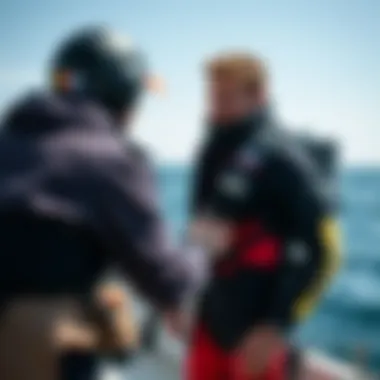
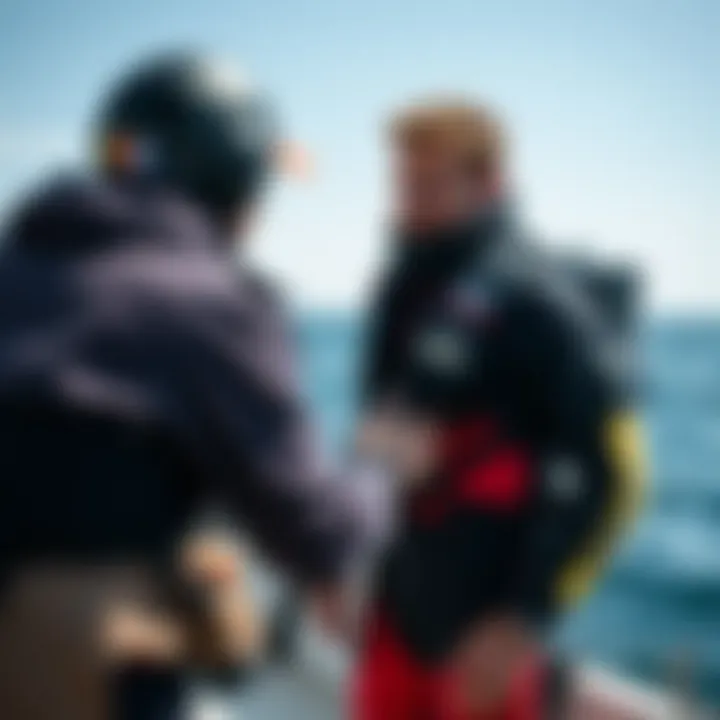
"Regular maintenance of your survival suit not only prolongs its lifespan but also ensures your safety while out at sea."
Proper fabric care is crucial not just for maintaining appearance but also for ensuring that the suit provides effective thermal insulation and waterproofing, both of which are necessary when facing unpredictable conditions at sea.
Storage Best Practices
Storing your survival suit correctly is equally vital in ensuring its longevity and functionality. Improper storage can lead to creases and degradation of materials. Here are some recommended practices that kiteboarders and water sports enthusiasts should consider:
- Clean Before Storing: Always ensure the suit is clean and dry before storage, as any moisture or dirt can lead to mold or long-term damage.
- Avoid Compression: Store the suit loosely in a dry, well-ventilated area. Avoid folding it too tightly or cramming it into small spaces, which can lead to creases and stress points.
- Cool Environment: Keep the suit in a cool environment away from direct heat sources. High temperatures can break down materials and reduce the suit’s functionality.
- Use Proper Bags: If possible, store the suit in a breathable bag. Avoid plastic, as it traps moisture and can foster an environment for mildew.
By following these maintenance and storage guidelines, you not only enhance the life of your survival suit but also ensure that it remains ready for action when you need it most. Keeping your survival gear in prime condition is just as critical as having it on board, especially in balancing thrill and safety while navigating the waters.
Regulatory Standards and Compliance
In the realm of sailing, particularly when it comes to survival suits, regulatory standards and compliance act as the backbone of safety and performance. These regulations ensure that every piece of equipment meets specific safety benchmarks, protecting users from inherent maritime dangers. Understanding these standards is crucial for sailors who often find themselves navigating unpredictable waters.
International Safety Regulations
International safety regulations are designed to create a uniform standard across nations for maritime safety gear. Organizations such as the International Maritime Organization (IMO) and the International Organization for Standardization (ISO) establish guidelines that manufacturers must follow. These regulations cover various aspects:
- Quality Assurance: Manufacturers must prove their suits can withstand extreme conditions, such as cold waters and high winds.
- Design Specifications: Suits should feature elements like buoyancy, heat retention, and visibility under low-light conditions.
- Testing Procedures: Compliance often requires rigorous field testing and lab verification ensuring that survival suits perform as intended in real-world scenarios.
Compliance with these regulations not only enhances the safety of individual sailors but helps foster trust within the maritime community. Failure to adhere to these standards can have dire consequences, potentially leading to injuries or fatalities in the event of an emergency. To keep updated on the latest safety regulations, sailors should refer to resources from organizations like IMO and ISO.
Manufacturer Compliance and Certifications
Manufacturers play a pivotal role in the effectiveness of survival suits. It’s not just about whipping up a suit that looks good on the outside. They must comply with stringent safety standards and obtain specific certifications. Compliance involves:
- Certification Bodies: Many manufacturers work with independent organizations that test and certify their suits against established standards, like the ISO 12402, which deals specifically with personal flotation devices and immersion suits.
- Transparency in Materials: Manufacturers should provide clear information about the materials used, ensuring they meet safety and durability standards.
- Ongoing Compliance Audits: Regular audits help maintain standards over time, ensuring that every batch of suits continues to meet safety requirements.
Always choose survival suits that meet international safety regulations and bear trusted certifications to ensure your safety in emergency situations.
Survival Suit Training and Usage
Understanding how to properly use a survival suit is crucial, especially for those who find themselves out on the swells. It’s not just about putting on the suit and hoping for the best; effective training can turn a potentially dire situation into a more manageable one. This part sheds light on the significance of undergoing proper training and knowing how to use survival suits effectively, which ultimately enhances safety while sailing.
Training isn't an optional add-on—it’s a necessity. There are countless risks sailors can face, from sudden plunges into frigid waters to emergencies where quick thinking and action are vital. The right training equips individuals not only with the skills necessary for using their suits but also with the confidence to react decisively in tough situations. Plus, it creates a chain reaction of awareness among the crew, promoting a culture of safety onboard.
Essential Training Modules
Training modules for survival suits generally cover a range of topics to ensure sailors feel ready for what might come their way. Here are some essential modules:
- Suit Familiarization: Understanding the design and functionality of different suits is the first step. Sailors learn how to don, adjust, and ensure the suit is secure yet comfortable.
- Emergency Procedures: This includes training on what to do in unexpected emergencies. Sailors need to practice getting into their life jackets and suits quickly, whether on a boat or during a man-overboard drill.
- Cold Water Survival Techniques: Knowledge of how to handle exposure to cold water is vital. This module typically includes both theory and practical drills.
- Inflation Systems Training: Many advanced suits come equipped with automatic inflation systems. It’s crucial to learn how these work and how to deploy them in various scenarios.
- Communication Skills: Being able to use built-in communication devices effectively can be lifesaving. Sailors should practice their operation while in the suits.
Emergency Scenarios and Drills
Training is not just about theoretical knowledge; it must integrate real-world applications. Engaging in emergency exercises is an excellent way to simulate potential scenarios sailors might encounter. Here are a few critical drills that should be incorporated into any training program:
- Man Overboard (MOB) Drills: One sailor acts as a casualty and jumps into the water while others practice retrieval techniques, emphasizing how to assist someone who has fallen overboard while ensuring their own safety.
- Capsize Situations: Sailors learn how to respond if their vessel capsizes, including quickly getting into their survival suits and using flotation aids.
- Cold Water Immersion: Controlled immersion in cold water allows sailors to experience the effects of cold shock, even if limited, which helps them understand the importance of maintaining composure and effectively using their survival suit.
Each of these drills not only reinforces skills but also builds team cohesion and trust amongst crew members.
Engaging in these scenarios repeatedly allows sailors to both internalize the procedures and handle the stress of emergency situations with greater ease.
Technological Innovations in Survival Suit Design
Survival suits have come a long way since their inception, and technological innovations play a pivotal role in enhancing both safety and performance for sailors. It’s not just about keeping warm and dry anymore; it's about adding layers of functionality that can mean the difference between life and death in a maritime emergency. The modern sailor needs to be equipped with suits that can perform under pressure, utilize cutting-edge materials, and integrate additional safety features that were once considered unimaginable.
Advancements in Fabrics and Materials
The development of advanced fabrics has transformed survival suits into high-performance gear. Traditional materials have given way to textiles that are lighter, more flexible, and incredibly durable. For example, the use of neoprene and Gore-Tex has revolutionized thermal protection and waterproofing.
- Lightweight Design: Newer materials are often lighter than ever, minimizing weight without compromising insulation.
- Breathability: Innovations in fabric technology, like the incorporation of microporous membranes, allow moisture to escape while keeping water out. This reduces the risk of overheating and discomfort during use.
- Enhanced Insulation: Materials that reflect body heat while still allowing for breathability are becoming standard. This combination helps maintain core temperature in frigid waters, significantly improving survival times.
Moreover, many modern fabrics are treated with special coatings that increase their resistance to abrasions and UV rays, ensuring they can withstand the harshest marine conditions. This is crucial for kiteboarders who not only face the challenges of cold water but also the wear and tear from their sport.
Integration of Communication Devices
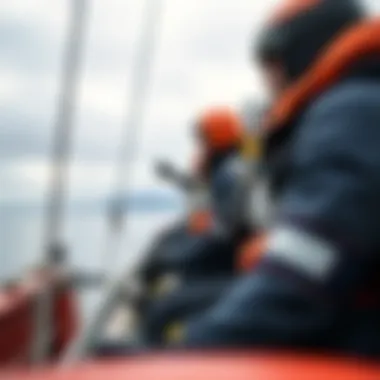
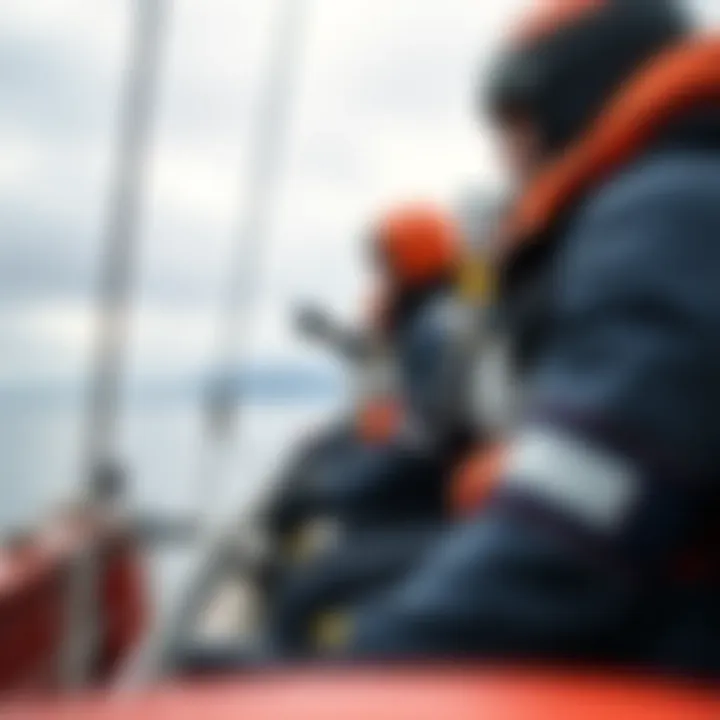
The integration of communication devices into survival suits is possibly one of the most significant leaps forward in personal safety gear. In a situation where every second counts, being able to communicate quickly can save lives.
- Built-in GPS Systems: Some survival suits now come with integrated GPS trackers that can alert rescue teams to a sailor's location. This can be crucial if an individual goes overboard.
- Emergency Beacons: Including distress beacons that can be activated by simply pulling a tab can signal for help. These devices often send out specific signals to nearby vessels or shorelines, increasing the chance of timely rescue.
- Two-way Radios: Incorporating two-way radios into the suit allows for direct communication with crew members or rescue services without needing to dig through gear to find a phone or radio. This hands-free capability provides a level of convenience and safety that is invaluable during crises.
Case Studies of Survival Suit Incidents
Understanding real-world incidents involving survival suits is crucial for grasping their potential impact on safety during sailing. These case studies often offer invaluable lessons about the efficacy of design, fit, and functionality under duress. As sailors venture into unpredictable waters, knowing the outcomes of past survival suit incidents can equip them with knowledge and awareness on essential safety practices.
Analysis of High-Profile Cases
High-profile cases of survival suit usage often provide striking insights that transcend typical safety protocols. For instance, the 2012 incident involving a fishing vessel, Sea Angel, highlighted the critical role of thermal protection. After capsizing during a storm, the crew was found wearing immersion suits, which were pivotal in preventing hypothermia. The suits’ ability to maintain body heat despite frigid waters allowed the crew to survive until rescue arrived.
Another noteworthy incident was the 2016 ferry sinking in the Mediterranean. Survivors who donned the appropriate survival suits during their evacuation were able to last much longer in the icy waters than those without. The contrast between the two groups provided concrete evidence of how survival suits can indeed make a life-or-death difference. Such cases emphasize the importance of not only having survival suits aboard but also ensuring they're effective and well-maintained.
Through these examples, it becomes clear that the effectiveness of survival suits directly affects the probability of survival in critical situations.
Lessons Learned from Real-Life Situations
Every incident relays a distinct set of lessons. One of the most recurring themes in survival suit case studies is the significance of proper fit. For instance, during a marine drill, a participant reported that their survival suit’s size was too large, causing buoyancy issues in water. This made it difficult to maneuver and could have resulted in exhaustion or drowning had the situation been real. This spotlight on size serves as a reminder that personalization is not just a matter of comfort but is fundamental to survival.
Another lesson revolves around the necessity of regular training in survival suit use. In another high-profile case from the Arctic Circle, research showed that crew members who practiced emergency scenarios involving their survival suits were quicker to react and much more efficient in utilizing the gear when faced with an actual emergency. With regular drills, the learned instinct can significantly enhance response times and overall safety.
“Embracing what we learn from past mistakes is key to ensuring a safer future on the water.”
By dissecting both the triumphs and failings of survival suit incidents, sailors can better equip themselves—both mentally and physically—against maritime challenges. It also underscores that the journey doesn't end once a suit is purchased; continual assessment and engagement are vital in ensuring each sailor arrives home safe at the end of their voyage.
Personal Stories and Experiences
In the realm of survival suit sailing, personal stories and experiences hold significant weight. They serve as powerful reminders of the unpredictable nature of the sea and the vital role that survival suits play in ensuring a sailor's safety. By sharing firsthand accounts, sailors can illustrate both the advantages and the limitations of their gear, offering invaluable insights that can guide others in their choices.
Testimonials from Sailors
Sailors often recount moments that define their experience on the water, instances where survival suits transitioned from mere gear to life-saving essentials. One common thread among these tales is how well-fitted suits allowed for mobility while providing essential warmth during unforeseen cold snaps. For instance, a sailor named Jack reflects on a harrowing experience off the coast of Maine, where a sudden squall caught him unawares.
"I’ll never forget the sheer panic. The wind whipped up like a beast, and I went overboard. My suit, snug yet comfortable, helped me float and regulate my body heat. It was my savior that day."
These personal accounts emphasize the dual function of a survival suit—not just protection against the elements but also a critical aid in maintaining calm during emergencies. Sailors like wave-rider Susan take it a step further by detailing how her suit’s visibility features helped rescuers locate her after an unfortunate capsize:
"I could see the rescue boat darting towards me, my bright orange suit flashing against the dark waves. I felt relieved knowing they would spot me quickly."
Such stories do more than just entertain; they educate sailors on the paramount importance of selecting features in their suits that cater to individual needs, visibility, and buoyancy.
Field Reports from Emergency Services
Emergency services personnel have seen it all from the frontline. Their reports underline crucial realities about survival suits that are often overlooked. First responders often assess the effectiveness of these suits during rescues, and they keep a close eye on the materials used and even the overall fit. A team leader for the Coast Guard, Alex, shared insights from a rescue operation:
"We often rely on the technology behind these suits. The better the suit acts in extreme conditions, the higher the survival rates we see. In a recent operation, we pulled two sailors from the water wearing outdated suits that simply didn’t hold up. We’ve observed that newer materials can truly mean life or death."
The service evaluation of different brands and models informs both sailors and manufacturers about what works best. The feedback loop is crucial; it drives innovation in safety gear, helping enhance designs to withstand harsh ocean environments.
Emergency services also emphasize the psychological empowerment that comes with wearing a high-quality survival suit. Rescue technicians have noted that sailors who are confident in their gear tend to be more composed during crises.
Each account, from sailors and emergency responders alike, serves as a cautionary tale and a source of inspiration. They compel us to approach every sailing trip with a heightened awareness of safety preparations and the gear we rely on.
Overall, personal experiences and field reports are essential to understanding survival suit sailing. They not only highlight functional facts but also imbue a sense of community and shared responsibility among sailors, ensuring that everyone is equipped to make well-informed decisions on the seas.
Culmination on Survival Suit Sailing
As we navigate the often turbulent waters of sailing, the significance of survival suits becomes increasingly evident. The unpredictable nature of the sea can thrust sailors into perilous situations in the blink of an eye, making having a reliable survival suit not just a precaution, but a necessity. Survival suits are designed to provide critical insulation, buoyancy, and protection against the elements, turning them into lifelines when emergencies arise.
The Future of Survival Gear
Looking ahead, the landscape of survival gear is poised for transformation. Innovations are sprouting up like wildflowers, driven by advancements in materials and technology. Expect to see the integration of smart fabrics that can monitor body temperature, hydration levels, and even communicate distress signals. Companies are already tinkering with materials that are lighter yet more effective at insulation. This could revolutionize how sailors experience comfort and protection. Moreover, sustainable fabrics are entering the scene, promising to deliver eco-friendly options without compromising on performance. In a world where environmental accountability is paramount, this development is not just welcome—it's necessary.
Additionally, there's a growing trend towards customizability. Sailors are looking for more than just one-size-fits-all solutions. Brands might offer tailored experiences that take individual body types and specific sailing environments into account. The blending of style with functionality can also be anticipated, with aesthetics playing a larger role in design without sacrificing safety.
Final Recommendations for Sailors
For sailors preparing to invest in survival suits, here are some practical recommendations:
- Prioritize Fit: Always ensure that the suit fits like a glove—too tight and it restricts movement, too loose and it can't provide adequate insulation. Consider going for brands offering fit guides and trying suits before purchase.
- Invest in Quality: A high price tag often correlates with superior materials and performance. When lives are on the line, it’s worth spending a little extra on quality gear.
- Stay Informed: Regularly update yourself on new developments in survival suits. Technology evolves faster than a sailor can pivot, so keep your ear to the ground.
- Educate Yourself and Your Crew: Conduct regular drills and training regarding how to properly don your survival suits. Familiarity can save crucial seconds in emergencies.
- Maintenance is Key: Take care of your equipment. Proper cleaning and storage can extend the lifespan of your suit significantly.
Ultimately, safety is the compass that should guide every decision made on the water. By selecting the right survival suit and understanding its proper use, sailors can ensure they remain prepared for whatever the ocean throws their way. The waves may be unpredictable, but with the right gear and knowledge, sailors can navigate them with confidence.







